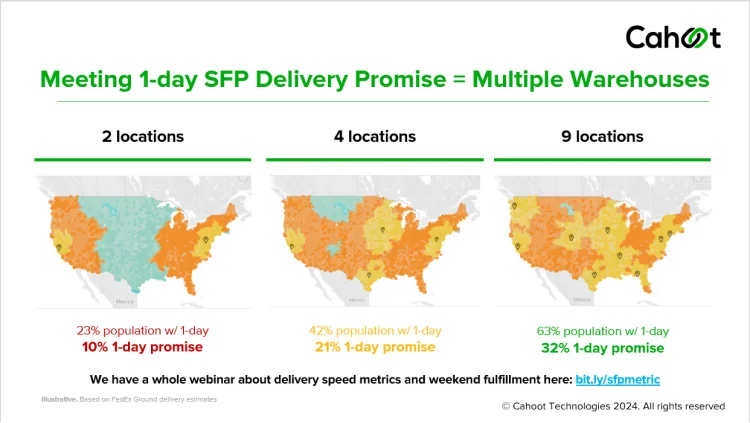For sellers aiming to succeed on Amazon, finding the most efficient and cost-effective fulfillment method is crucial. While Fulfillment by Amazon (FBA) has long been a go-to option for many sellers, recent shifts in pricing dynamics have left some reevaluating their strategies.
With FBA fees steadily on the rise, including significant increases in shipping costs, sellers are exploring alternative fulfillment methods to maintain profitability. Enter Amazon Seller Fulfilled Prime (SFP), a solution that offers the coveted Prime badge without the hefty fees associated with FBA.
In a recent development, one seller reported a whopping 476% surge in FBA shipping fees over just 40 days following the implementation of the new inventory placement fees.
Against this backdrop, our article delves into the benefits of Seller Fulfilled Prime and how savvy sellers can leverage this option to their advantage. We’ll explore how SFP empowers sellers to maintain Prime eligibility while retaining greater control over fulfillment operations and costs, providing a viable alternative in an increasingly competitive marketplace.
Stay tuned for insights on maximizing the potential of Amazon Seller Fulfilled Prime to enhance your selling experience.
What is Seller Fulfilled Prime?
Amazon Seller Fulfilled Prime (SFP) is the Prime program that allows sellers to deliver directly to domestic Prime customers from their own warehouse. Seller Fulfilled Prime offers show the Prime branding and are delivered with one-day and two-day delivery at no additional charge for Prime customers.
From a buyer’s perspective, it’s no different from FBA. The only difference is that the seller fulfills the order through their own warehouse or a third-party logistics (3PL) service, not Amazon.
How is Amazon Seller Fulfilled Prime Different from FBA?
However, behind the scenes, a few areas make SFP, if not better, different from FBA.
Amazon Fees FBA vs SFP
FBA charges a flat fee per unit fulfilled, while with Seller Fulfilled Prime, you can manage your own expenses. So, for items that are generally oversized or bulky, it’s often a great idea to ship them yourself because shipping costs can be lower.
Inventory Flexibility
FBA has quirks that make some SKUs expensive. These fees include higher storage fees in Q4, storage utilization surcharges, inventory placement fees, and aged inventory fees. These make storing items that don’t move quickly problematic. In addition, storage limitations limit how much inventory can be sent to their facilities, thus preventing sellers from responding rapidly to bursts of demand for seasonal goods or viral items.
Sales Channel Flexibility
FBA is not the most cost-effective option for multi-channel fulfillment. Amazon FBA Multi-Channel Fulfillment (MCF) allows sellers to use FBA to ship orders purchased outside Amazon, like on their own website. This helps make FBA inventory move faster but often costs more than shipping them yourself.
SFP is not just about boosting your business on Amazon. The fast shipping fulfillment operation you’ve put in place can now be offered on other channels. Your website can now offer one-day and two-day delivery promises, and so too your other marketplaces like Walmart, eBay, Target, Etsy, etc.
Reverse Logistics
Flexible returns is one of the benefits of SFP vs FBA, as Seller-fulfilled items are sent back to your specified return shipping address, which could be the closest warehouse to the customer or the shipment’s origin address. This differs from FBA, where all returns go to an Amazon warehouse. With Amazon SFP, you have more flexibility in inspecting and restocking your returned items.
Delivery Speed
FBA is not guaranteed to have fast delivery. There have been reports in some parts of Washington State that FBA delivery can take as long as 4-5 days.
In summary, Amazon SFP fulfillment offers sellers an alternative to Amazon FBA, with lower shipping costs, storage fees, and better flexibility.
Key takeaways
Seller Fulfilled Prime works best for the following scenarios:
- Oversized and bulky items that are typically expensive at FBA
- Slower moving items that rack up long-term storage when put in FBA
- Seasonal items that are often hit by inventory limits at FBA
- A seller considering offering fast shipping across all channels, not just Amazon
What is the Difference between FBM and SFP?
Amazon Seller Fulfilled Prime (SFP) and Fulfilled by Merchant (FBM) are similar in the sense that both involve sellers taking responsibility for fulfilling orders themselves rather than using Amazon’s warehouses like FBA. However, there are some key differences between the two:
- Prime Eligibility: SFP specifically focuses on enabling sellers to offer Prime shipping benefits to customers while handling fulfillment independently. This means sellers who qualify for SFP can display the Prime badge on their listings and provide Prime-level shipping speeds to Prime members.
- Stringent Requirements: SFP comes with stringent requirements set by Amazon to ensure that sellers can consistently meet Prime-level service standards, including fast shipping and reliable delivery. Sellers must demonstrate their ability to consistently meet these standards to maintain their SFP status. More on that later.
- Customization and Control: While both SFP and FBM allow sellers to maintain control over fulfillment, SFP sellers must adhere to specific shipping requirements outlined by Amazon to maintain Prime eligibility. This may include using specific carriers, meeting delivery windows, and offering free shipping on Prime-eligible orders.
Amazon Seller Fulfilled Prime allows sellers to fulfill orders themselves while still providing Prime-level shipping benefits to customers. While similar to FBM in that sellers handle fulfillment independently, SFP comes with additional requirements and expectations to maintain Prime eligibility.
FBA vs FBM
Fulfilled by Amazon (FBA) and Fulfilled by Merchant (FBM) are two distinct fulfillment methods available to Amazon sellers, each offering unique advantages and considerations.
Fulfillment and Logistics
FBA entails sending inventory to Amazon’s fulfillment centers (FCs), where Amazon handles storage, packing, shipping, and customer service on behalf of the seller. This option is ideal for sellers looking to streamline operations and leverage Amazon’s vast logistics network.
With FBA, you can benefit from Prime eligibility, which often leads to higher conversion rates and increased visibility for your products. Additionally, FBA eliminates the need for you to manage inventory and fulfill orders yourself, freeing up time to focus on other aspects of your business.
For example, a seller of electronic gadgets may opt for FBA to ensure fast and reliable delivery to customers, enhancing the overall shopping experience and driving sales.
On the other hand, FBM involves storing, packing, and shipping orders directly to customers from your own facilities or third-party logistics providers.
While FBM requires you to handle more of the fulfillment process yourself, it offers greater flexibility and control over inventory management and shipping methods. You can customize packaging, include promotional materials, and implement specific shipping strategies tailored to your brand and customer base.
For instance, a seller of handmade crafts may choose FBM to maintain a personal touch in packaging and to offer expedited shipping options during peak seasons, enhancing customer satisfaction and loyalty.
Amazon FBA vs FBM Fees
Amazon FBA charges you for various services, including storage fees (monthly charges based on the volume of space occupied by their inventory in Amazon’s warehouses), fulfillment fees (charged per unit for picking, packing, and shipping orders), and additional fees for optional services like labeling and removal.
With FBM, you are responsible for all aspects of fulfillment, including storage, packaging materials, and shipping costs. Amazon does not charge fulfillment fees for FBM orders since you are handling these tasks independently.
While FBA vs FBM fees are no joke, it may seem that the former generally comes with lower fees compared to the latter. However, if choosing FBM, you may miss out on the benefits of Prime eligibility and the convenience of Amazon’s logistics infrastructure.
In sum, FBA’s fee structure is continually evolving, posing challenges for sellers, especially newcomers or those with slim profit margins. Assessing whether FBM outweighs FBA in terms of cost is crucial. FBA may prove more economical, particularly for high-volume sales or complex shipping needs due to its scale advantages, but FBM offers flexibility and control.
Comparing factors like labor costs, warehousing expenses, storage fees, picking, packing, and shipping costs is essential to make an informed decision between FBA vs FBM.
When determining the most suitable fulfillment model for you, consider using FBA vs FBM calculator to ensure that you accurately assess the costs associated with your products.
Seller Feedback
Amazon’s feedback system serves as a channel for customers to express their satisfaction with sellers and the transactions conducted on the platform. It comprises two main components – Star Ratings and Comments.
Star Rating: Shoppers can rate a seller’s performance on a scale from 1 to 5, akin to a product review.
Comments: In addition to the star rating, customers have the option to leave comments explaining the rationale behind their rating.
It’s important to distinguish between seller ratings and product ratings/reviews. Seller ratings specifically refer to aspects of the transaction itself, such as shipping, product accuracy, and seller communication.
For sellers utilizing FBA, where Amazon manages most fulfillment tasks, concerns regarding seller feedback are somewhat alleviated. In instances where Amazon handles an FBA seller’s transaction and negative feedback ensues, the seller can request its removal.
Conversely, sellers operating under FBM have more control over their transactions, thereby facing a higher risk of negative seller feedback. Consequently, FBM sellers must prioritize product condition, shipping speed, and communication with buyers to mitigate the likelihood of unfavorable feedback on Amazon.
Which Fulfillment Method is Better?
The choice between FBA vs FBM depends on various factors such as seller preferences, business model, fees, product types, and market dynamics. But for sellers seeking a cost-effective fulfillment method, FBM may be preferable as it typically incurs lower fees compared to FBA.
Overall, understanding the differences between these fulfillment methods and strategically leveraging their respective benefits allows you to optimize your operations and maximize your success on Amazon.
What are the Amazon SFP Requirements?
The Seller Fulfilled Prime program was closed to sellers for years until Amazon made sweeping changes in October 2023. Professional sellers can now apply for the Amazon SFP 30-day trial period and, once they pass, become enrolled SFP sellers.
Below is the list of Seller Fulfilled Prime requirements for an enrolled seller:
- Free one-day and two-day delivery for Prime customers
- Free nationwide standard shipping for all customers
- Meet minimum thresholds for one-day and two-day delivery speeds as viewed by Prime customer detail page views
- An on-time delivery rate of at least 93.5%
- A valid tracking rate of at least 99%
- A seller-initiated cancellation rate of less than 0.5%
- Ship and deliver Prime orders on weekends (Saturday, Sunday, or both)
- Offer Free Returns on items weighing under 50 lb
- All post-order customer service inquiries are managed by Amazon
The list of requirements above seems unassuming; however, there is one metric that is both confusing and very tough for sellers to meet.
Amazon Seller Fulfilled Prime Delivery Speed Metrics are Tricky
| Size tier | Same-day | ≤ 1 day | ≤ 2 day |
|---|---|---|---|
| Standard size | N/A | ≥ 30% | ≥ 70% |
| Oversize | N/A | ≥ 10% | ≥ 45% |
| Extra large | N/A | N/A | ≥ 15% |
When sellers see the one-day and two-day delivery promise requirement, it’s easy to think they simply want you to use next-day and 2-day air options. However, this metric is different.
When a Prime shopper goes into a product listing on Amazon and sees “Free delivery Tomorrow. Order within 2hrs”. In this scenario, if the customer purchases it within 2 hours, the order will be shipped out today and will be delivered to the buyer the next day. This counts as meeting both the one-day delivery promise and the two-day delivery promise.
However, an offer can be configured for one-day or two-day delivery but provide a 3, 4, or even 5+ day delivery promise when viewed by the customer due to order, cut-off time, seller weekend operations, carrier weekend operations, and holidays. Just because a seller is using one-day overnight delivery or 2-day air using services like FedEx OneRate or other guaranteed services, it doesn’t mean the offer will meet the one-day and two-day delivery metric.
Let’s examine the following examples to see how differences in timing can affect whether or not a listing meets or fails the delivery speed metric. Let’s assume a seller has a 2 PM order cutoff time, operates Monday through Saturday, and delivers every package within one day.
Example 1: Page viewed before cutoff time
A shopper sees the product details page on Monday at 1 PM, before the cut-off time. That order will ship the same day, Monday, and will be delivered on Tuesday. So, this particular page view meets the one-day metric, which also implies that it meets the two-day metric.
Example 2: Page viewed after the cutoff time
A shopper sees your product details page on Monday at 5 PM, after the cut-off time. That order will ship tomorrow, Tuesday, and will be delivered on Wednesday. So, this particular page view does not meet the one-day metric, but it still meets the two-day metric.
Example 3: Page viewed on the weekend, after the cutoff time
A shopper sees your product details page on Saturday at 5 PM, after the cut-off time. Since the warehouse is closed on Sundays, that order will ship next Monday and will be delivered next Tuesday. So, this particular page view does not meet the one-day metric and the two-day metric.
| Example 1 | Example 2 | Example 3 | |
|---|---|---|---|
| When is it viewed? | Monday 1 pm | Monday 5 pm | Saturday 5 pm |
| Ships on | Monday | Tuesday | Next Monday |
| Delivers on | Tuesday | Wednesday | Next Tuesday |
| One-day or less promise | ✓ | ✕ | ✕ |
| Two-days or less promise | ✓ | ✓ | ✕ |
What’s more surprising is that even if a seller operates on Saturday/Sunday and overnights 100% of their shipments, half the time, their listing won’t meet a one-day promise. Even in the best-case scenario, you have at most 14 hours of one-day page view metric on weekdays. This excludes taking into account carrier delays, inclement weather, and public holidays.

The Amazon Seller Fulfilled Prime delivery speed metric is a complex yardstick that is more than just using expedited air delivery services. It’s tied to when and where customers are viewing your product listing. 100% overnight shipping does not mean a 100% one-day delivery metric.
Seller Fulfilled Prime Requires Multiple Warehouses
Now that we understand how Delivery Speed Metrics are calculated. To achieve the 30% or more one-day delivery promise target from Amazon, a seller must have multiple strategically located warehouses. This way, the seller can deliver things quickly and affordably using ground services like UPS or FedEx Ground.
Having more warehouses means more people being in close proximity to inventory. Therefore, orders can be delivered faster for less. The image below illustrates how having 4 to 9 locations can help sellers achieve their Amazon Seller Fulfilled Prime metrics.

The locations need to be tailored to your customer base. For example, pool supplies would be more popular in the South than in the North. Therefore, the ideal warehouse locations would be closer to California, Texas, and Florida.
Sellers need to keep in mind that what is required to ensure disruptions to the business won’t immediately lead to disqualification from the Amazon Seller Fulfilled Prime Program. This also means SFP only makes sense once the seller achieves a certain scale where splitting inventory makes sense.
For example, if a seller only has four units of an item, it does not make sense to split them into 6 locations.
Achieving delivery speed metrics requires sellers to have multiple strategically located warehouses tailored to their customer base. So, orders can be shipped affordably using ground shipping.
Achieving SFP Success with 3PLs
Most businesses don’t operate multiple warehouses, so expanding and acquiring warehouses are costly investments that are also difficult to optimize. Therefore, it is very difficult for a seller to meet Amazon Seller Fulfilled Prime requirements solely using their own warehouses.
Fortunately, sellers now have access to 3PL companies that offer SFP fulfillment services. Select providers like Cahoot operate on weekends, have late cutoffs, and offer affordable fast shipping to support SFP requirements.
For a more streamlined fulfillment and logistics process, use an advanced inventory management solution like SoStocked. Efficiently manage multiple warehouses with SoStocked by setting up each warehouse location, syncing inventory data, and optimizing inventory allocation based on demand and proximity to customers. Monitor inventory movement in real-time and adjust strategies to maintain optimal stock levels. Utilize analytics and forecasting to streamline order management and stay competitive.
We hope these tips will help you find success in Amazon Seller Fulfilled Prime and achieve more than what you’ve done with FBA!




